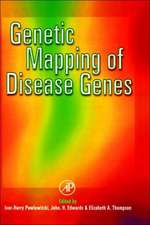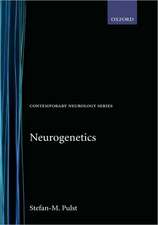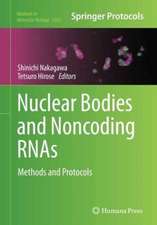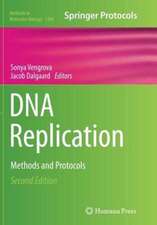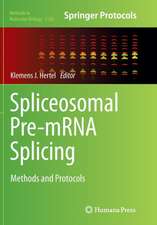MicroRNA Protocols: Methods in Molecular Biology, cartea 342
Editat de Shao-Yao Yingen Limba Engleză Hardback – apr 2006
| Toate formatele și edițiile | Preț | Express |
|---|---|---|
| Paperback (3) | 598.68 lei 38-44 zile | |
| Springer – 10 dec 2019 | 598.68 lei 38-44 zile | |
| Humana Press Inc. – 23 aug 2016 | 789.04 lei 6-8 săpt. | |
| Humana Press Inc. – dec 2010 | 947.67 lei 6-8 săpt. | |
| Hardback (3) | 919.97 lei 6-8 săpt. | |
| Springer – 13 feb 2018 | 919.97 lei 6-8 săpt. | |
| Humana Press Inc. – apr 2006 | 954.77 lei 6-8 săpt. | |
| Humana Press Inc. – 26 sep 2012 | 1112.17 lei 6-8 săpt. |
Din seria Methods in Molecular Biology
- 9%
 Preț: 791.59 lei
Preț: 791.59 lei - 23%
 Preț: 598.56 lei
Preț: 598.56 lei - 20%
 Preț: 882.95 lei
Preț: 882.95 lei -
 Preț: 252.04 lei
Preț: 252.04 lei - 5%
 Preț: 802.69 lei
Preț: 802.69 lei - 5%
 Preț: 729.61 lei
Preț: 729.61 lei - 5%
 Preț: 731.43 lei
Preț: 731.43 lei - 5%
 Preț: 741.30 lei
Preț: 741.30 lei - 5%
 Preț: 747.16 lei
Preț: 747.16 lei - 15%
 Preț: 663.45 lei
Preț: 663.45 lei - 18%
 Preț: 1025.34 lei
Preț: 1025.34 lei - 5%
 Preț: 734.57 lei
Preț: 734.57 lei - 18%
 Preț: 914.20 lei
Preț: 914.20 lei - 15%
 Preț: 664.61 lei
Preț: 664.61 lei - 15%
 Preț: 654.12 lei
Preț: 654.12 lei - 18%
 Preț: 1414.74 lei
Preț: 1414.74 lei - 5%
 Preț: 742.60 lei
Preț: 742.60 lei - 20%
 Preț: 821.63 lei
Preț: 821.63 lei - 18%
 Preț: 972.30 lei
Preț: 972.30 lei - 15%
 Preț: 660.49 lei
Preț: 660.49 lei - 5%
 Preț: 738.41 lei
Preț: 738.41 lei - 18%
 Preț: 984.92 lei
Preț: 984.92 lei - 5%
 Preț: 733.29 lei
Preț: 733.29 lei -
 Preț: 392.58 lei
Preț: 392.58 lei - 5%
 Preț: 746.26 lei
Preț: 746.26 lei - 18%
 Preț: 962.66 lei
Preț: 962.66 lei - 23%
 Preț: 860.21 lei
Preț: 860.21 lei - 15%
 Preț: 652.64 lei
Preț: 652.64 lei - 5%
 Preț: 1055.50 lei
Preț: 1055.50 lei - 23%
 Preț: 883.85 lei
Preț: 883.85 lei - 19%
 Preț: 491.88 lei
Preț: 491.88 lei - 5%
 Preț: 1038.84 lei
Preț: 1038.84 lei - 5%
 Preț: 524.15 lei
Preț: 524.15 lei - 18%
 Preț: 2122.34 lei
Preț: 2122.34 lei - 5%
 Preț: 1299.23 lei
Preț: 1299.23 lei - 5%
 Preț: 1339.10 lei
Preț: 1339.10 lei - 18%
 Preț: 1390.26 lei
Preț: 1390.26 lei - 18%
 Preț: 1395.63 lei
Preț: 1395.63 lei - 18%
 Preț: 1129.65 lei
Preț: 1129.65 lei - 18%
 Preț: 1408.26 lei
Preț: 1408.26 lei - 18%
 Preț: 1124.92 lei
Preț: 1124.92 lei - 18%
 Preț: 966.27 lei
Preț: 966.27 lei - 5%
 Preț: 1299.99 lei
Preț: 1299.99 lei - 5%
 Preț: 1108.51 lei
Preț: 1108.51 lei - 5%
 Preț: 983.72 lei
Preț: 983.72 lei - 5%
 Preț: 728.16 lei
Preț: 728.16 lei - 18%
 Preț: 1118.62 lei
Preț: 1118.62 lei - 18%
 Preț: 955.25 lei
Preț: 955.25 lei - 5%
 Preț: 1035.60 lei
Preț: 1035.60 lei - 18%
 Preț: 1400.35 lei
Preț: 1400.35 lei
Preț: 954.77 lei
Preț vechi: 1164.35 lei
-18% Nou
Puncte Express: 1432
Preț estimativ în valută:
182.69€ • 190.75$ • 151.20£
182.69€ • 190.75$ • 151.20£
Carte tipărită la comandă
Livrare economică 05-19 aprilie
Preluare comenzi: 021 569.72.76
Specificații
ISBN-13: 9781588295811
ISBN-10: 1588295818
Pagini: 380
Ilustrații: XIV, 366 p. 83 illus., 3 illus. in color.
Dimensiuni: 155 x 235 x 29 mm
Greutate: 0.71 kg
Ediția:2006
Editura: Humana Press Inc.
Colecția Humana
Seria Methods in Molecular Biology
Locul publicării:Totowa, NJ, United States
ISBN-10: 1588295818
Pagini: 380
Ilustrații: XIV, 366 p. 83 illus., 3 illus. in color.
Dimensiuni: 155 x 235 x 29 mm
Greutate: 0.71 kg
Ediția:2006
Editura: Humana Press Inc.
Colecția Humana
Seria Methods in Molecular Biology
Locul publicării:Totowa, NJ, United States
Public țintă
ResearchCuprins
The MicroRNA: Overview of the RNA Gene That Modulates Gene Functions.- Structure Analysis of MicroRNA Precursors.- MicroRNA Biogenesis: Isolation and Characterization of the Microprocessor Complex.- Recognition and Cleavage of Primary MicroRNA Transcripts.- Mouse Embryonic Stem Cells as a Model Genetic System to Dissect and Exploit the RNA Interference Machinery.- MicroRNAs and Messenger RNA Turnover.- Prediction of MicroRNA Targets.- Prediction of Human MicroRNA Targets.- Complications in Mammalian MicroRNA Target Prediction.- miRBase:The MicroRNA Sequence Database.- Methodologies for High-Throughput Expression Profiling of MicroRNAs.- In Situ Hybridization as a Tool to Study the Role of MicroRNAs in Plant Development.- Usefulness of the Luciferase Reporter System to Test the Efficacy of siRNA.- Cloning MicroRNAs From Mammalian Tissues.- Methods for Analyzing MicroRNA Expression and Function During Hematopoietic Lineage Differentiation.- Identifying MicroRNA Regulators of Cell Death in Drosophila.- MicroRNAs in Human Immunodeficiency Virus-1 Infection.- Cloning and Detection of HIV-1-Encoded MicroRNA.- Identification of Messenger RNAs and MicroRNAs Associated With Fragile X Mental Retardation Protein.- In Vitro Precursor MicroRNA Processing Assays Using Drosophila Schneider-2 Cell Lysates.- Downregulation of Human Cdc6 Protein Using a Lentivirus RNA Interference Expression Vector.- Gene Silencing In Vitro and In Vivo Using Intronic MicroRNAs.- Isolation and Identification of Gene-Specific MicroRNAs.- Transgene-Like Animal Models Using Intronic MicroRNAs.- Evolution of MicroRNAs.- Perspectives.
Textul de pe ultima copertă
It is now known that microRNA (miRNA), once thought to be junk, can suppress the expression of other genes and may be involved in numerous cellular processes, including cell proliferation, apoptosis, cell differentiation, and development. In MicroRNA Protocols, expert miRNA researchers explain its basic concepts and introduce the most advanced technologies and techniques for predicting screening, isolating, and assaying it. The authors provide diverse, novel, and useful descriptions of miRNAs in several species-including plants, worms, flies, fish, chicks, mice, and humans-and show how they have been employed to develop miRNA as a potential drug design tool. Highlights include miRNA and their target prediction by computer analysis, functional assays of miRNA in vitro and in vivo, and transgenic animal models using miRNA technologies. Additional chapters cover gene regulation, small RNA function, RNA interference mechanisms, and transgenetics. The protocols follow the successful Methods in Molecular Biology™ series format, each offering step-by-step laboratory instructions, an introduction outlining the principles behind the technique, lists of the necessary equipment and reagents, and tips on troubleshooting and avoiding known pitfalls.
Eminently practical and cutting-edge, MicroRNA Protocols affords biomedical researchers readily reproducible techniques to understand and study the molecular pathogenesis of disease and design new therapeutic strategies.
Eminently practical and cutting-edge, MicroRNA Protocols affords biomedical researchers readily reproducible techniques to understand and study the molecular pathogenesis of disease and design new therapeutic strategies.
Caracteristici
Includes supplementary material: sn.pub/extras

